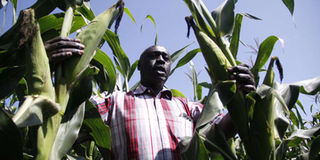High production cost a food security threat

A maize farmer inspects his healthy maize crops in a farm in Uasin Gishu. PHOTO | FILE | NATION MEDIA GROUP
What you need to know:
- High cost of inputs has caused some Kenyan farmers to abandon farming.
- Most poor households are food-insecure, negatively affecting the socio-economic state of the country.
- Maize farmers have complained of being unable to sell their produce due to cheap imports from South Africa and Uganda.
- Kenya risks being fed solely by its less-developed neighbours
The VAT Act 2013 was aimed at easing administration of value added tax by reducing the number of zero-rated items. That led to imposition of a 16 per cent VAT on farm inputs such as seeds, fertiliser and pesticides, as well as components used in their manufacture, increasing the cost of farm inputs and, in turn, the production cost for food items and animal feed.
Tegemeo Institute estimated that the tax alone would increase the cost of producing a 90-kilogramme bag of maize by 5-6 per cent.
Additionally, high cost of inputs has caused some Kenyan farmers to abandon farming altogether, reduce the acreage under food or use low-quality inputs.
This results in lower yields, causing food shortages which were exacerbated by last year’s prolonged drought.
Overall, less food is available for the country and it’s too costly. Households reportedly spend up to 60 per cent of their income on food purchases as the cost of food items rises.
FOOD IMPORTS
Most poor households are food-insecure, negatively affecting the socio-economic state of the country.
In the first half of the year, food imports increased by up to 50 per cent; 20 per cent of the import bill was attributed to food items, which points to a country that is largely food-insecure with the government having to subsidise the cost of maize flour to cushion citizens.
Paradoxically, maize farmers have complained of being unable to sell their produce due to cheap imports from South Africa and Uganda.
Similarly, cheap imports have made locally manufactured sugar unsellable in the local market, hitting sugarcane farmers hard.
The high cost of food production has seen Kenyan farmers priced out of the market by cheaper imports.
OPENING UP BORDERS
Consequently, Kenya exports the much-needed jobs even as agriculture employs up to 70 per cent of the workforce, mainly in the rural areas.
Furthermore, regional bodies such as Comesa and the East African Community (EAC) have been campaigning for the opening up of borders and relaxation of tariffs to ease regional trade.
With the food produced locally being uncompetitive, Kenya risks being fed solely by its less-developed neighbours.
This has the implication of increasing food insecurity and volatility should the countries shut the door on food exports, upsets the balance of payments and leads to a depreciation of the Kenya shilling.
Food security is one of the ‘Big Four’ pillars, and rightly so. Ambitious targets for food have been set, together with corresponding capital outlays.
IRRIGATION
Some 2.79 million bags of maize have been targeted for the year with 52,000 acres set to be put under rice, potatoes and other food crops.
Emphasis has been put on improving post-harvest practices with reduced taxes for imported construction materials for storage structures.
More land is expected to be put under irrigation to reduce reliance on erratic rainfall.
Small-scale farmers produce the bulk of food in Kenya. Their being efficient and cost-effective is key to ensuring food security while securing family incomes and the entire economy.
The government should lower the cost of food production.
Ms Nyaga is an accountant. [email protected].





